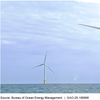U.S. Department of Energy’s Wave Energy Prize announces nine finalist teams to continue in quest to win more than $2 million prize purse
The U.S. Department of Energy (DOE) announced that nine teams have been named finalists in the Wave Energy Prize—a 20-month design-build-test competition—and will proceed to the next phase of the competition.
The nine finalists and two alternates, identified from the 17 remaining official qualified teams, will continue their quest to double the energy captured from ocean waves and win a prize purse totaling more than $2 million. Each of the finalists and alternates will now receive seed funding from DOE to develop 1/20th scale models of their wave energy converter (WEC) technologies. These models will be tested at the nation's most advanced wave-making facility, the Naval Surface Warfare Center's Maneuvering and Seakeeping (MASK) Basin at Carderock, Md., beginning in the summer of 2016.
Official finalist teams are:
- AquaHarmonics (Portland, Ore.)
- CalWave (Berkeley, Calif.)
- M3 Wave (Salem, Ore.)
- Oscilla Power (Seattle, Wash.)
- RTI Wave Power (York, Maine)
- Sea Potential (Bristol, R.I.)
- SEWEC (Redwood City, Calif.)
- Wavefront Power (Team FLAPPER) (Research Triangle Park, N.C.)
- Waveswing America (Sacramento, Calif.)
Alternate teams are:
- McNatt Ocean Energy (Annapolis, Md.)
- Wave Energy Conversion Corporation of America (WECCA) (North Bethesda, Md.)
-
“The qualified teams’ efforts resulted in some very promising technologies for the judges to evaluate,” said Wes Scharmen, principal investigator at Ricardo, Inc. and chief judge of the Wave Energy Prize. “Based on our preliminary evaluation, the data indicates that many of the teams identified as finalists have the potential to achieve the ACE threshold, and thus the potential to exceed DOE’s program goal. We’re looking forward to further verifying their designs performance at 1/20th scale in the MASK Basin at Carderock this summer.”
ACE—a benefit-to-cost ratio—was selected by the Wave Energy Prize as a metric appropriate for comparing low Technology Readiness Level WEC concepts when there is not enough data to calculate the levelized cost of energy—itself a cost-to-benefit ratio—from a device. ACE is determined by dividing, in essence, the wave energy extraction efficiency of a WEC by its structural cost. Finalists were determined based on their potential to achieve the doubling of the current state-of-the-art ACE value of 1.5 meters per million dollars (m/$M) to 3 m/$M during 1/20th scale tank testing at the MASK Basin, making them eligible to win the grand prize.
A panel of expert judges evaluated each qualified team based on their revised technical submissions, numerical modeling results, Model Design and Construction Plans, and the results of small-scale tank testing of their 1/50th scale models, and determined aggregate scores to identify the finalist pool.
The Wave Energy Prize is encouraging the development of game-changing WECs that will reduce the cost of wave energy, making it more competitive with traditional energy solutions.














